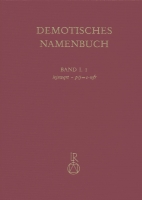Search
Im Auftrag der Akademie der Wissenschaften und der Literatur, Mainz. Begründet von Erich Lüddeckens, fortgeführt von Heinz-Josef Thissen unter Mitarbeit von W. Brunsch, G. Vittmann und K.-Th. Zauzich
Demotisches Namenbuch Gesamtband
2000
20.0 x 28.0 cm, 1630 p., cloth, in 3 Teilbänden, Band 1: 472 S., Band 2: 480 S., Band 3: 678 S.
ISBN: 9783895001680
20.0 x 28.0 cm, 1630 p., cloth, in 3 Teilbänden, Band 1: 472 S., Band 2: 480 S., Band 3: 678 S.
850,00 €
ISBN: 9783895001680
Short Description
Demotic texts contain a lit of personal names which are frequently difficult to read. Here, the “Demotisches Namenbuch” offers invalueable help. By consulting the main part, indices and addenda, the user will get information about where, when, in which writing a given name may be found in Demotic.Knowledge of Demotic is by no means presupposition for drawing profit from the “Demotisches Namenbuch”. No egyptologist tackling personal names especially from the Late Period can afford to ignore the ast Demotic evidence assembled here, all the less so because several names happen to be attested only in Demotic, but not in hierroglyphs.
Many names are of non-Egyptian origin. By using the indices, specialists in the fields of Greek papyrology, Semitic, Iranic or Meroitic may easily know which foreign names are found in Demotic transmission. Last but not least: As the names frequently have a religious background, this work is also a rich source for the study of deities and cults of the Late Period.
Description
In former years, due to the difficulty of writing, Demotic studies have been considered something of an “arcane discipline” on the border of traditional Egyptologe, cultivated just by a few specialists. In the last years, however, this situation has changed. The number of students of Demotic has largely increased, and accordingly, many new texts of different kinds are being published. Thus, it is only now that the true richness of Demotic literature is becoming clear.Demotic texts contain a lot of personal names which are frequently difficult to read. It is true, of course, that the numerous juridical and administrative documents are built up in a rather schematic manner, but the names are varying from one document to another. Here, the “Demotisches Namenbuch” offers invaluable help. By consulting the main part, indices and addenda, the user will get information about where, when, in which writing a given name may be found in Demotic. In
addition to this, Hieroglyphic and Greek correspendences are noted, and, as far as possible, the name is translated. Although for practical reasons only a characteristical selection of examples can be offered for each name, it may be seen easily which names were current, and which ones were rather rare.
Knowledge of Demotic is by no means presupposition for drawing profit from the “Demotisches Namenbuch”. No egyptologist tackling personal names especially from the Late Period can afford to ignore the vast Demotic evidence assembled here, all the less so because several names happen to be attested only in Demotic, but not in hieroglyphs. Many nanies are of non-Egyptian origin. By using the indices, specialists in the fields of Greek papyrology, Semitic, Iranic or Meroitic may easily know which foreign names are found in Demotic transmission. Last but not least: As the names frequently have a religious background, this work is also a rich source for the study of deities and cults of the Late Period.
also a rich source for the study of deities and cults of the Late Period.






 Neuerscheinungen 2023/2024
Neuerscheinungen 2023/2024
 Gesamtverzeichnis 2023/2024
Gesamtverzeichnis 2023/2024
 Katalog Oriental Studies & Linguistics
Katalog Oriental Studies & Linguistics
 Mittelalter
Mittelalter
 Deutsche Inschriften
Deutsche Inschriften
 Musiktherapie
Musiktherapie
 Literaturen im Kontext
Literaturen im Kontext